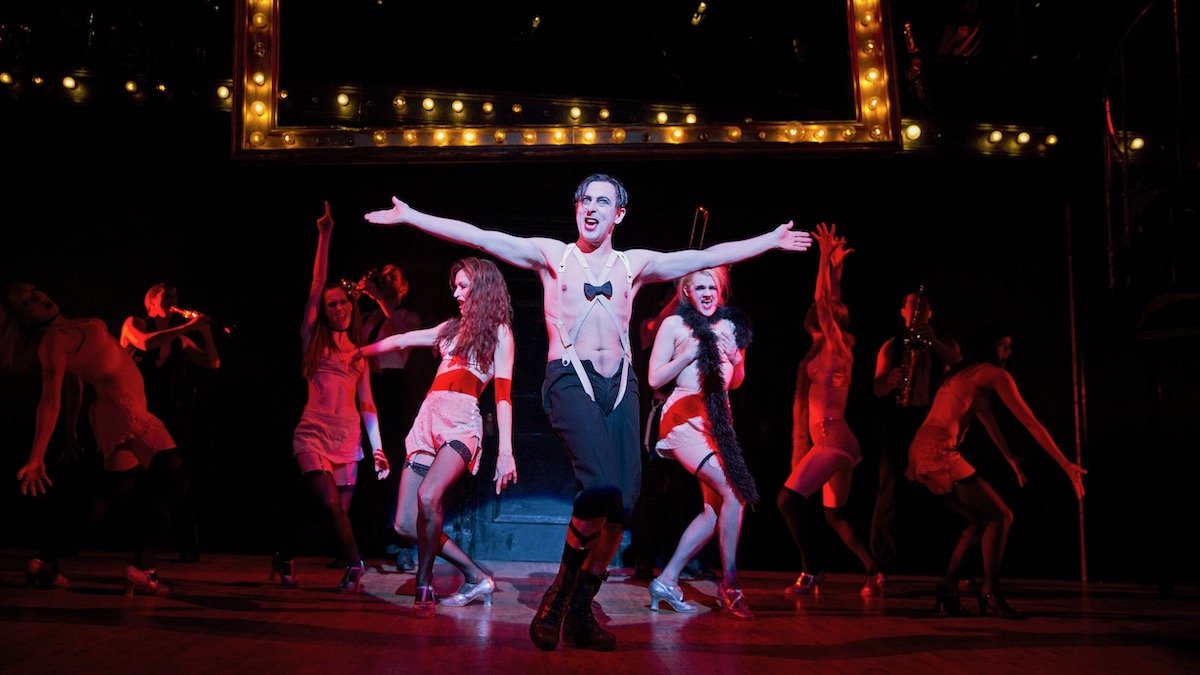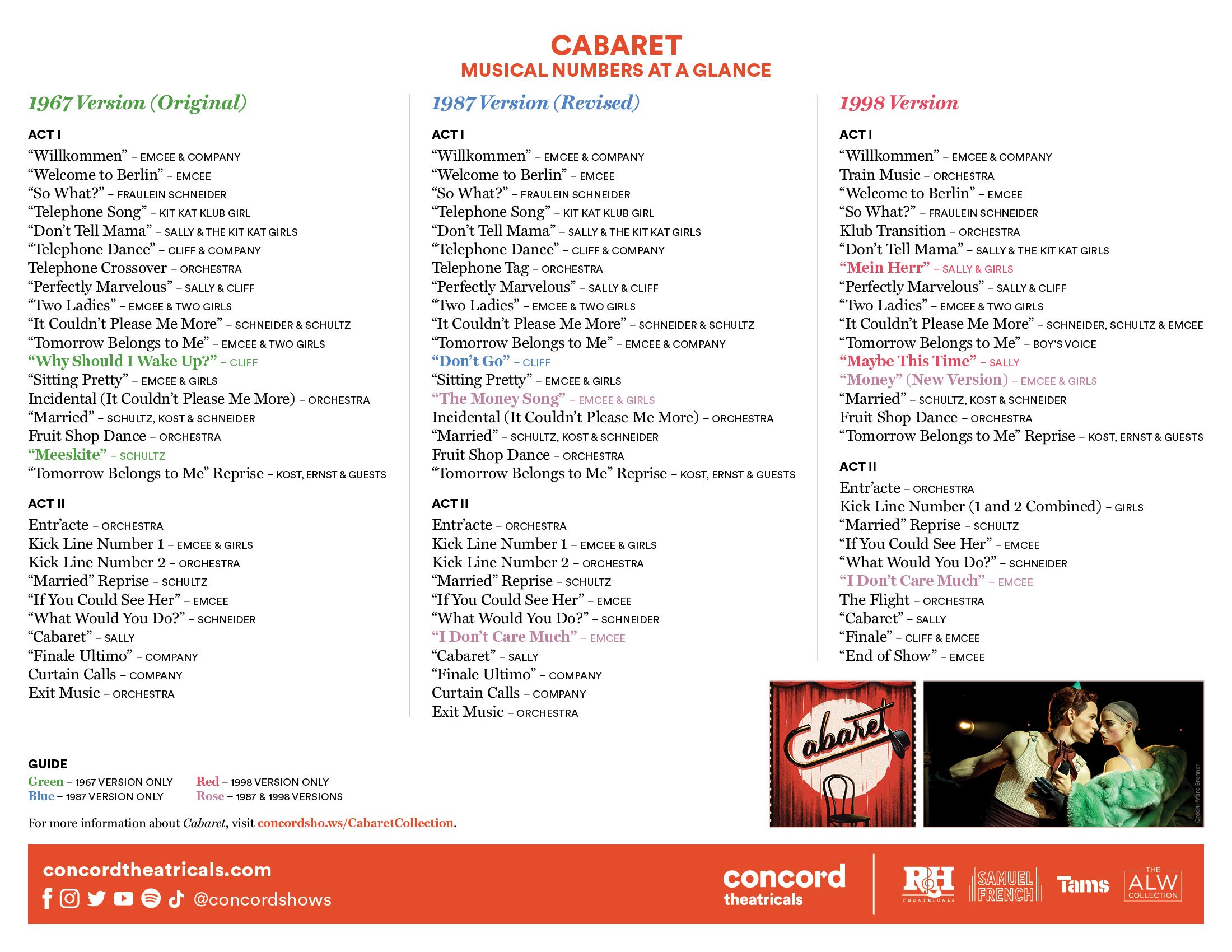
Concord Theatricals proudly licenses three versions of Cabaret (Book by Joe Masteroff, based on the play by John Van Druten and stories by Christopher Isherwood, with music by John Kander and lyrics by Fred Ebb). The musical has undergone a few revisions as it’s been revived over the decades; though the characters remain the same, some scenes and musical numbers were changed with each new iteration. Here’s a guide to help you distinguish the three versions of the piece, along with a handy “at-a-glance” chart of the musical numbers in each edition.
…
At its heart, Cabaret exposes a nation with a confused sense of morality, at a time when moral corruption is on the rise.
Before Cabaret, there was a book. Goodbye to Berlin, by Christopher Isherwood, is a semi-autobiographical work about Isherwood’s time in the Weimar Republic and his intimate friendship with a cabaret singer. This book served as the basis for a play; I Am a Camera (US/UK), a 1951 drama by John Van Druten, looks at life in a tawdry Berlin rooming house. The play centers on the life of the mercurial and somewhat sad Sally Bowles (Isherwood’s cabaret singer), who lives a vacant life in 1930s Berlin. The play briefly touches on the experience of Jewish people in Germany as the Nazis rise to power.
Cabaret (Original 1966), a musical adaptation of the novel and play, opened on Broadway at the Broadhurst Theatre, later transferring to the Imperial and the Broadway. It closed in 1969 after over 1,000 performances. This original production of Cabaret was directed by Harold Prince and choreographed by Ron Field. Audiences initially questioned the show’s “immoral content,” but it gained traction following a slew of positive reviews, and people flocked to the theatre — transformed from a Broadway house into the musky Kit Kat Klub.
The original production has two exclusive songs: Cliff Bradshaw, the ex-pat Isherwood stand-in, sings “Why Should I Wake Up?” and Herr Schultz sings “Meeskite,” about a love that defies physical attraction.
The 1972 film adaptation of Cabaret, directed by Bob Fosse, won eight Oscars and still holds the record for the most Oscars earned by a film not honored for Best Picture. (The Godfather took that prize in 1972.) John Kander and Fred Ebb penned three new songs for the movie: “Mein Herr,” “The Money Song” and “Maybe This Time.” The movie excises the love story between Fraulein Schneider and Herr Schultz, which explores the consequences that befall a Jewish man and a Gentile woman who fall in love during a time when antisemitism reigns. Some of the couple’s numbers, including “Married,” still appear in the film as incidental music.
Cabaret (Revised 1987) uses the score and libretto for the musical’s first Broadway revival, which opened at the Imperial Theatre and ran for 300 performances.
The revised score features powerful new musical numbers, including “The Money Song” (from the film) and “I Don’t Care Much,” which also appear in the ‘98 revival. “Don’t Go,” Cliff’s solo lament, replaces “Why Should I Wake Up?” and is the only song exclusive to the 1987 edition of the musical.
Cabaret (1998 Version) reflects Cabaret’s second Broadway revival, derived from Sam Mendes’ 1993 West End production of the musical, which included much content from the 1972 film. Rob Marshall, who worked on the film version of Chicago, served as the co-director and co-choreographer for this production. This revival ran for a record 2,377 performances, which made it the third-longest running revival in Broadway history. The production received ten Tony Award nominations in the year of its premiere.
This edition features a majorly revised score, including a streamlined version of “The Money Song” titled “Money.” The song that typically precedes “Money,” “Sitting Pretty,” does not appear in this version. Instead, Sally Bowles’ numbers from the film line the score, including the club number “Mein Herr” and the heart-wrenching ballad “Maybe This Time.” The score as a whole is condensed here — the instrumental “Telephone Song” is cut, and the two kick line numbers are abridged as a single string of music and movement. The 1998 edition of Cabaret is only available for licensing in the US.
One more difference among the three versions of Cabaret concerns their treatment of Cliff Bradshaw’s sexual orientation. In the 1966 version, there is no suggestion of a queer identity. In the 1987 revision, it is implied that Cliff may be bisexual. In the 1998 version, which includes a brief scene in which Cliff kisses a one of the Kit Kat Klub boys, Cliff’s queerness is made explicit. Christopher Isherwood himself — the author of the novel that started it all, himself the basis for the fictional Cliff Bradshaw — was a homosexual expat who traveled to 1930s Berlin in search of sanctuary and sexual liberation.
See below for a quick look at the musical numbers that appear in each version of Cabaret.
For a downloadable PDF of the above image, click here.
…
Peruse all three versions of Cabaret at concordsho.ws/CabaretCollection.

Noël Coward’s Travels

Kate Chopin in New Orleans: Mother-Daughter Author Duo Collaborate on Historical Book


